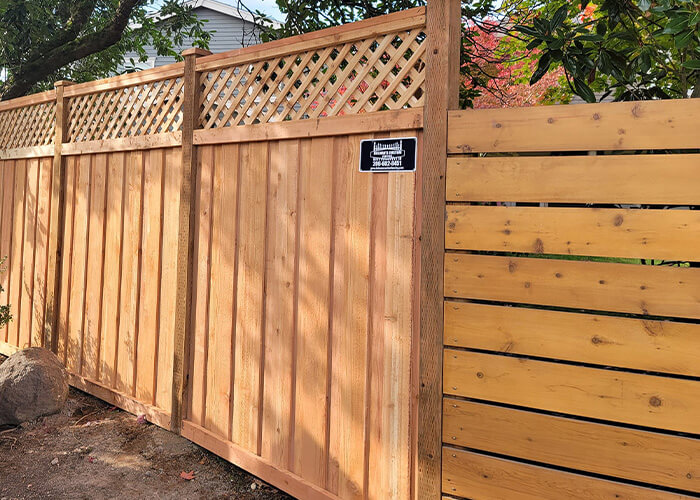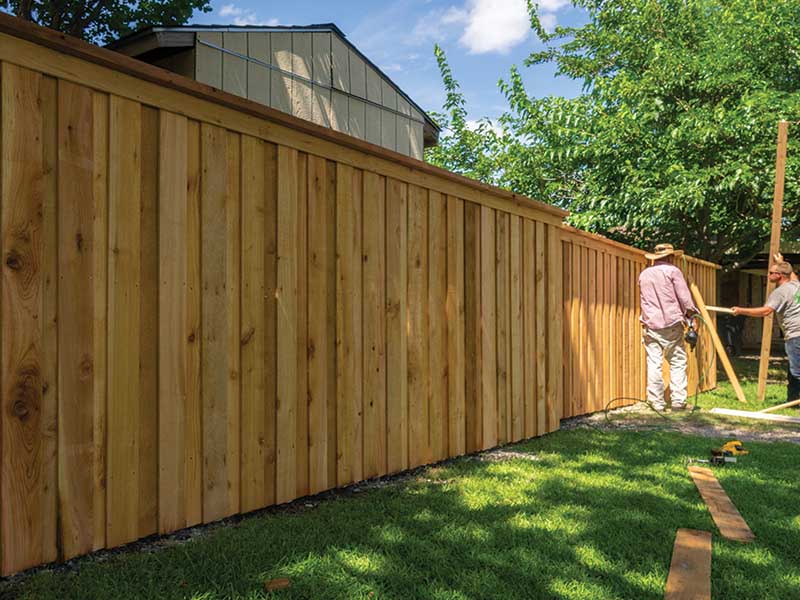How to Identify Common Problems That Need Immediate Fencing Repair
When it involves maintaining your fence, it is important to detect problems prior to they become bigger troubles. Routinely examining for indications of decomposing timber, leaning panels, or rust can conserve you time and cash in the future. You might not understand just how climate and pests can compromise your fence's stability. Allow's discover the common indicators that indicate your fence needs prompt interest, so you can keep your property safe and looking its best.
Indications of Rotting Timber in Wooden Fences
Have you discovered your wood fencing looking a bit worse for wear? If so, it could be time to look for indications of rotting wood. Check out the base of the articles and panels for soft places. If you press on the wood and it feels squishy or collapses, that's a clear indicator of rot. Next, try to find staining or dark areas on the timber-- these usually signal dampness damage. Take notice of any type of peeling paint or finish, as this can reveal the timber to further degeneration. Additionally, a poignant, mildewy scent can show fungal growth. Do not forget to check connections and joints; if they hang or crumbling, the timber under is most likely compromised. By catching these indications early, you can prevent much more comprehensive damages and keep your fencing standing strong. Normal upkeep is crucial to prolonging the life of your wooden fencing.
Leaning or Tilting Fencing Panels
If you have actually seen your fence panels leaning or tilting, it's essential to understand what caused it. This issue could indicate underlying architectural damages that needs your interest. Let's explore the usual reasons and the fixing alternatives readily available to obtain your fencing back fit.
Sources Of Leaning Panels
When you discover your fencing panels turning or leaning, it's often an indication of underlying problems that require dealing with. One common reason is poor drain; excessive water can erode the dirt around the fencing blog posts, weakening their support. An additional offender might be solid winds or storms that press versus the panels, particularly if they're not correctly anchored. Additionally, the all-natural settling of dirt gradually can create articles to move, leading to a tilt. Parasites, like termites, can compromise the honesty of wood panels, causing them to lean as well. Ultimately, poor setup techniques might cause panels not being firmly established, leaving them vulnerable to leaning under stress. Address these issues immediately to preserve your fencing's honesty.
Signs of Structural Damage
Seeing turning or leaning fence panels can be startling, as these concerns commonly indicate architectural damage that needs immediate attention. When your fencing begins to lean, it may signal that the blog posts are moving or that the soil around them has actually worn down. Pay very close attention to voids between articles or panels, as these can additionally suggest instability. deck builder. Additionally, check for fractures or splintering in the wood, which can weaken the general structure. If you notice corrosion or deterioration on steel elements, it can endanger the integrity of the fencing. Remember, ignoring these indicators can cause a lot more serious damage down the line, so it's necessary to analyze the circumstance immediately and do something about it before it intensifies
Repair Service Options Available

Rust and Deterioration in Metal Fences
If you possess a metal fencing, you may notice corrosion and rust creeping in over time, specifically if it's subjected to moisture. These concerns not only affect the appearance of your fencing but can also compromise its architectural stability. To identify corrosion, search for reddish-brown spots or spots, which indicate the metal is oxidizing. Deterioration can spread promptly if left without fence repair treatment, compromising the fencing and leading to expensive repairs.To tackle rust and rust, you ought to cleanse the impacted locations with a cable brush and use a rust-inhibiting primer. When the guide dries out, think about painting the fence with a weather-resistant paint to safeguard it better. Normal upkeep, such as inspecting for signs of corrosion and retouching paint as required, will assist expand your fence's lifespan. Addressing these issues immediately assures your steel fencing continues to be strong and visually appealing for several years to find.
Fractures and Splits in Vinyl Fence

Root Causes Of Plastic Damage
Plastic secure fencing is popular for its resilience, yet it can still deal with cracks and splits as a result of different variables. One significant reason is extreme temperature fluctuations. It can compromise the material over time when vinyl increases in the warmth and agreements in the chilly. Furthermore, exposure to harsh sunlight can lead to UV degradation, making the plastic weak. Physical influences, like heavy branches or unintentional accidents, can also create cracks. Poor installation or using low-grade materials can aggravate these issues. Age plays a function; older plastic fence is more at risk to damage. Routine examinations can help you recognize these aspects before they cause significant problems. Take positive actions to guarantee your fencing remains solid and intact.
Repairing Cracks Effectively
Splits and divides in your vinyl fence can be worrying, resolving them without delay can stop additional damage and preserve the fencing's appearance. Evaluate the dimension of the split. For tiny splits, a plastic fixing set usually consists of sticky that can bond the edges, offering a smooth fix. Clean the location extensively before using the adhesive, ensuring it sticks appropriately. For bigger splits, you may need to make use of a plastic spot. Cut the patch to size, apply glue around the edges, and press it strongly onto the split. Allow it to treat as per the manufacturer's directions. Routine upkeep and quick repairs can extend your fence's life-span, maintaining it looking terrific for years ahead.
Loosened or Missing Out On Fence Blog Posts
Loosened or missing fence blog posts can weaken the stability of your whole fencing framework. It's vital to deal with the issue promptly if you observe any type of blog posts tottering or leaning. Look for any indicators of activity, as this can result in more damages gradually. You can quickly assess the issue by giving each message a mild shake-- if it feels unsteady, it's time to take action.For missing posts, you'll require to replace them immediately to preserve your fencing's integrity. When you install new posts, ensure they're safely anchored in the ground with concrete or gravel for included stability. If a message is loosened, tighten it by including added assistance or driving it deeper right into the ground.Ignoring these issues can cause bigger troubles, like spaces in your fence or also total collapse. Maintain an eye on your messages and remain aggressive concerning repair work!
Damage From Weather and Natural Components
Weather and natural elements can damage your fencing, leading to various kinds of damages that require punctual attention. Hefty rain can trigger wood to rot, making it weak and unstable. Snow build-up may flex or break panels, while solid winds can root out fencing articles or cause sections to lean.If you discover splits or splintering in wooden fences, it suggests drying out because of extreme sun exposure. Metal fences can rust if protective layers wear off, specifically in humid or coastal areas.Inspect your fencing consistently after storms or severe weather condition to catch any type of damage early. Addressing these issues rapidly can conserve you from costly repair work down the line. Don't wait up until a little trouble develops into a major one; stay positive and maintain your surround top shape to keep both functionality and curb charm.
Bug Invasion and Termite Damage
It's important to act promptly to avoid further destruction when you see indicators of bug invasion or termite damage. Search for mud tubes along your fence or hollow-sounding wood, as these indicate termites go to work. You may likewise see little openings or frass, which is termite droppings looking like sawdust. If you find any one of these signs, it's time to analyze the damage.Don' t delay up until it's far too late; pests can compromise your fencing's integrity. Examine the surrounding location for ants or beetles, as they may be adding to the problem. If you believe an invasion, take into consideration contacting a pest control professional to treat the issue.repairing and validate or changing afflicted sections of your fencing immediately not only restores its strength but likewise protects against pests from spreading additionally. Remain vigilant to maintain your home safe and pest-free.
Regularly Asked Concerns
Just how Frequently Should I Evaluate My Fence for Damages?
You should evaluate your fence at the very least two times a year, ideally throughout spring and autumn. Routine checks assist you find damages early, saving you money and time on repair work while keeping your property's appearance and protection.
Can I Repair a Fencing Myself or Hire a Specialist?
If you have the right tools and abilities, you can absolutely fix a fence yourself. Nonetheless, hiring an expert guarantees quality job and conserves you time, especially for complicated repairs or comprehensive damages.
What Tools Are Required for Basic Fence Fixings?
For standard fencing repair work, you'll need tools like a hammer, screwdriver, pliers, a saw, a degree, and determining tape. deck builder. Depending on the repair service, you could also require nails, screws, or substitute boards
Just How Much Does Fencing Repair Service Normally Expense?
Fence repair work expenses differ commonly, but you can expect to pay between $200 and $1,500 depending on materials, labor, and extent of damages. It's clever to obtain multiple quotes for the finest offer.
When Is the most effective Time of Year for Fencing Services?
The most effective time for fence repair work is during light weather condition, normally in spring or early loss. You'll stay clear of severe temperatures, making it simpler to work and guaranteeing the materials set properly for lasting toughness (deck builder). Observing tilting or leaning fence panels can be startling, as these concerns often indicate structural damage that needs prompt focus. Loose or missing fencing blog posts can undermine the stability of your entire fence structure. Snow build-up could flex or break panels, while strong winds can root out fence blog posts or cause areas to lean.If you discover splits or splintering in wooden fencings, it's a sign of drying out due to extreme sunlight direct exposure. Metal fences can corrosion if protective coverings put on off, particularly in coastal or moist areas.Inspect your fence routinely after storms or severe climate to capture any damages early. Fencing repair work prices vary extensively, but you can expect to pay in between $200 and $1,500 depending on materials, labor, and degree of damage